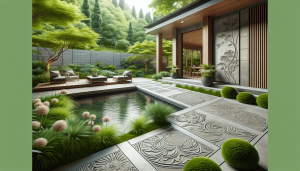Eco-Friendly Kitchen Materials for Sustainable Living
As modern homeowners become increasingly conscious of their environmental impact, the quest for eco-friendly kitchen materials has gained significant momentum. Sustainable living is not just a trend; it’s a lifestyle choice that encourages individuals to make mindful decisions about the resources they use and the materials they select for their homes. When it comes to kitchens, choosing eco-friendly materials can contribute to healthier living spaces while reducing one’s carbon footprint.
One of the first considerations should be the countertops. Traditional materials like granite or laminate often involve heavy energy consumption and harmful chemical processes. Instead, consider alternatives such as:
- Bamboo: Fast-growing and renewable, bamboo is a strong and durable option for countertops. It adds a unique aesthetic to any kitchen and can be sourced sustainably.
- Recycled Glass: Made from post-consumer glass, this material provides a striking visual element. It’s not only attractive but also durable and easy to maintain.
- Concrete: Concrete countertops can incorporate recycled materials like glass or stone. By customizing the design and finish, you can create a one-of-a-kind look while being environmentally responsible.
When selecting cabinetry, options made from sustainable wood or reclaimed materials are essential. Conventional cabinetry often uses woods from unsustainable sources, contributing to deforestation. Consider the following:
- FSC-Certified Wood: Sourcing wood products that are certified by the Forest Stewardship Council ensures that the materials come from responsibly managed forests.
- Reclaimed Wood: Salvaged wood from old barns or furniture repurposes existing materials, giving them a second life while reducing waste.
- Composite Materials: Made from recycled wood fibers or other sustainable materials, composite cabinetry can be a chic alternative that minimizes environmental impact.
In terms of flooring, the choices are vast. Opting for eco-friendly options not only enhances the look of your kitchen but also adheres to sustainable practices. Here are some favorite eco-friendly flooring materials:
- Cork: Sustainable and soft underfoot, cork is harvested from the bark of cork oak trees, allowing the trees to regrow. It’s naturally resistant to mold and mildew, making it an excellent choice for areas prone to moisture.
- Linoleum: Often mistaken for vinyl, linoleum is made from natural materials like linseed oil, pine resin, and cork dust. It’s biodegradable and can last for decades when properly maintained.
- Recycled Tile: Tiles made from post-consumer materials, such as glass or ceramics, can provide beautiful and durable surfaces. They often come in a variety of colors and patterns, allowing for creative and unique designs.
Another aspect to keep in mind is the kitchen’s appliances. While they are often considered separate from the structure, energy-efficient appliances play a significant role in maintaining an eco-friendly kitchen. The EPA’s ENERGY STAR program is a helpful resource for selecting efficient models. Look for:
- Energy-efficient refrigerators and dishwashers: These appliances not only conserve water and energy but also lower utility bills.
- Induction cooktops: More efficient than traditional gas or electric stovetops, induction cooktops require less energy to achieve the desired heat.
- Low-flow faucets: Installing low-flow faucets will reduce water consumption without sacrificing performance.
Consider the importance of paint and finishes used in your space. Conventional paints often contain volatile organic compounds (VOCs) that can be detrimental to indoor air quality. Look for:
- Non-toxic paints: Brands that offer low or zero-VOC paints can keep your kitchen fresh and healthy.
- Natural finishes: Opt for natural oils or waxes to treat surfaces instead of chemical-laden synthetic products.
By choosing eco-friendly kitchen materials, homeowners can create beautiful, functional spaces that reflect their commitment to sustainability. From countertops to appliances, every choice counts in building a modern kitchen that is as kind to the planet as it is stylish and functional. Embracing these materials not only reduces environmental impact but also fosters a healthier living environment for you and your family.
The Benefits of Bamboo as a Kitchen Material
Bamboo has gained popularity in recent years as an eco-friendly material, particularly in modern kitchens. This versatile grass offers an array of benefits that make it a smart choice for home design, from sustainability to aesthetics. Let’s dive into the reasons why bamboo stands out as an exceptional kitchen material.
Durability and Strength
Bamboo is incredibly strong, often compared to hardwoods like oak and maple. Its natural structure enables it to withstand heavy use, which is especially beneficial for kitchen environments. Countertops and cutting boards made from bamboo resist chipping and cracking, ensuring they maintain longevity even in the busiest kitchens. This durability translates to less frequent replacements, reducing waste and consumption over time.
Eco-Friendliness
One of the most significant advantages of bamboo is its environmental impact. Unlike traditional hardwood trees, bamboo grows rapidly, with some species reaching maturity in just three to five years. This fast growth cycle means that bamboo can be harvested sustainably without causing long-term damage to forests. Additionally, bamboo absorbs more carbon dioxide and releases more oxygen than most tree species, making it an excellent choice for eco-conscious homeowners.
Low Chemical Emission
Many kitchen materials, including laminate and certain types of engineered wood, can emit volatile organic compounds (VOCs) that negatively affect indoor air quality. Bamboo, especially when sourced from reputable suppliers, usually contains lower levels of these harmful chemicals. Opting for bamboo can contribute to a healthier home environment, enhancing air quality and overall wellness.
Aesthetically Pleasing
The natural beauty of bamboo adds a unique charm to any kitchen. Its distinct grain pattern and warm color tones can complement a wide variety of design styles, from modern minimalist to rustic farmhouse. Here are a few ways to incorporate bamboo into kitchen design:
- Cabinetry: Bamboo cabinets provide a sleek and contemporary look.
- Countertops: The elegant grain patterns of bamboo can elevate your cooking workspace.
- Flooring: Bamboo flooring offers warmth and resilience, making it suitable for high-traffic areas.
- Accessories: From cutting boards to kitchen utensils, bamboo accessories add a touch of nature to your kitchen.
Ease of Maintenance
Caring for bamboo kitchen materials is straightforward. Simply wipe down surfaces with a damp cloth and mild soap to keep them clean. Unlike some hardwoods, bamboo doesn’t require frequent sealing or special treatment, which can save both time and money in maintenance efforts. It also resists water damage and warping when properly cared for, making it highly suitable for areas exposed to moisture.
Versatility
The adaptability of bamboo is another compelling reason to consider it for your kitchen. Here are some areas where bamboo shines:
- Countertops: Bamboo countertops are available in various styles and finishes, allowing homeowners to choose what fits their design vision.
- Backsplashes: A bamboo backsplash can create a stunning focal point while being practical.
- Furniture: Chairs and tables made from bamboo not only look great but can be remarkably lightweight and easy to move.
- Storage Solutions: Bamboo shelves and organizers add functionality and style to your kitchen.
Cost-Effectiveness
When comparing bamboo to traditional hardwood materials, many times, bamboo can offer a more cost-effective solution. This affordability makes it accessible for homeowners looking to create a stylish and eco-friendly kitchen without breaking the bank. Additionally, considering the durability and longevity of bamboo, the investment pays off over time.
The benefits of incorporating bamboo into a modern kitchen are numerous. From its impressive durability and eco-friendliness to its aesthetic appeal and ease of maintenance, bamboo proves to be a wise choice for today’s environmentally aware homeowner. As more people prioritize sustainable living, bamboo is a material that stands out, combining beauty, functionality, and responsibility in one package.
Recycled Glass: A Stylish Choice for Modern Kitchens
In the quest for sustainable living, many homeowners are exploring eco-friendly materials that not only reduce their environmental footprint but also enhance the aesthetic appeal of their homes. Among the innovative options available, recycled glass stands out as a stylish and sustainable choice for modern kitchens.
Recycled glass is created by repurposing old glass containers and products, which significantly decreases landfill waste. This process not only conserves natural resources but also requires less energy compared to manufacturing new glass. Homeowners looking to incorporate recycled glass into their kitchens can do so in various ways, ensuring that their space remains elegant while still being conscious of the environment.
Types of Recycled Glass Applications
When it comes to incorporating recycled glass, there are several applications to consider:
- Countertops: One of the most popular uses of recycled glass is in kitchen countertops. These surfaces combine crushed glass with epoxy resin, resulting in a durable and unique option that’s available in a variety of colors and styles.
- Backsplashes: Adding a recycled glass backsplash can transform a kitchen’s look. They reflect light beautifully and can range from minimalist designs to more vibrant, colorful arrangements.
- Flooring: Recycled glass tiles make for stunning flooring options. These tiles are made from 100% recycled materials and can be crafted into different designs, enhancing any kitchen’s style.
- Accessories: Beyond larger installations, small items like bowls, vases, and decorative pieces made from recycled glass can add a touch of sustainability without overwhelming the space.
Benefits of Recycled Glass in the Kitchen
Choosing recycled glass offers numerous benefits for modern kitchens:
- Sustainable: By opting for recycled glass, homeowners contribute to reduced energy consumption and less waste.
- Durability: Recycled glass materials are tough and resistant to staining and scratching. This makes them an excellent choice for high-traffic areas like kitchens.
- Unique Aesthetic: Each piece of recycled glass has its own character, creating a one-of-a-kind look that cannot be replicated. This uniqueness can serve as a conversation starter among guests.
- Easy Maintenance: Surfaces made from recycled glass are easy to clean and maintain, ensuring a sanitary environment for food preparation.
Design Possibilities with Recycled Glass
With recycled glass, design possibilities are vast. Homeowners can play with colors, textures, and finishes:
- Color Variety: Recycled glass is available in a wide range of colors. From serene blues and greens to vibrant reds and yellows, there’s a shade to complement any kitchen design.
- Texture Options: Textured glass can add depth and interest to surfaces, inviting tactile interaction.
- Mix and Match: Pairing recycled glass with other eco-friendly materials like bamboo or reclaimed wood can create a harmonious and stylish kitchen aesthetic.
Considerations for Installation
Before diving into a recycled glass project, keep a few considerations in mind:
- Installation Costs: While recycled glass is a sustainable option, the initial costs can be higher compared to traditional materials.
- Professional Installation: Due to its weight and unique properties, hiring professionals for installation is recommended to ensure durability and safety.
- Long-term Performance: Although recycled glass is durable, certain precautions, such as avoiding excessive heat directly on surfaces, can prolong its lifespan.
Recycled glass into modern kitchens strikes a balance between sustainability and style. This eco-friendly material not only minimizes environmental impact but also provides a chic and contemporary look. From countertops to chic decor, the versatility of recycled glass makes it a fabulous choice for those aiming for both aesthetics and eco-consciousness in their kitchen designs.
Low-VOC Paints and Their Role in Eco-Friendly Interiors
Creating eco-friendly interiors often starts with choosing the right materials and products, and one of the most significant options is paint. Low-VOC (Volatile Organic Compounds) paints have gained popularity for their ability to enhance the aesthetic of a home while minimizing potential harm to the environment and our health. By opting for low-VOC paints, homeowners can significantly contribute to a healthier indoor environment.
Traditionally, many paints released VOCs, which are harmful chemicals that can easily evaporate at room temperature. These compounds are known to contribute to air pollution and can lead to various health issues, such as headaches, respiratory problems, and even long-term neurological damage. Low-VOC paints, in contrast, contain fewer of these volatile compounds, making them a safer choice for both the environment and indoor air quality.
When choosing low-VOC paints, homeowners can expect several benefits:
- Improved Air Quality: By limiting the release of harmful gases, low-VOC paints help maintain better indoor air quality. This is particularly beneficial for people who suffer from allergies or respiratory issues.
- Less Odor: These paints emit a much lower odor than conventional paints. This makes the job of painting more pleasant and ensures that rooms can be used sooner after painting.
- Reduced Environmental Impact: Low-VOC paints are typically made with more sustainable practices and materials. By choosing these products, homeowners contribute to reducing environmental pollution.
- Diverse Options: Low-VOC paints are available in a wide range of colors and finishes, allowing homeowners to achieve their desired look without compromising on any aesthetic appeal.
- Durability: Many low-VOC paints are designed to be just as durable as their higher-VOC counterparts, meaning they maintain their beauty and effectiveness for years.
Choosing a low-VOC paint involves a few important considerations:
- Research the Brands: Not all paints labeled as low-VOC are created equal. It’s essential to research different brands and their VOC content. Aim for products with a VOC level of 50g/L or less.
- Check for Certification: Look for certifications from organizations such as Green Seal or the EPA’s Safer Choice program. These certifications ensure that the product meets specific environmental and health standards.
- Consider the Finish: Different finishes can have varying levels of VOCs. Generally, flat finishes tend to have lower VOC levels compared to glossy ones. Ensure that the finish aligns with your aesthetic desires and environmental goals.
To further enhance the eco-friendliness of your home, consider the following tips when using low-VOC paints:
First, ensure proper ventilation during and after the painting process. Open windows and use fans to help disperse any lingering fumes. This will facilitate quicker drying and minimize any discomfort associated with paint odors.
Second, invest in good-quality brushes and rollers. High-quality tools not only make your painting job more manageable but also lead to a smoother finish, which may prolong the paint’s life and limit the need for frequent repainting.
Additionally, plan your painting projects during favorable weather conditions. When it’s warm and dry, paint adheres better, which can reduce the time needed for touch-ups and repairs later on.
Always dispose of materials properly. Many communities have designated paint disposal days, and it’s vital to follow local guidelines to ensure safe and responsible disposal of any leftover paint and materials.
In a world increasingly aware of environmental issues, using low-VOC paints is a straightforward yet impactful way to contribute to a more sustainable future. By choosing these paints, not only do you create a healthier living environment, but you also take an essential step toward supporting sustainable living practices. Whether you’re refreshing a single room or undertaking a more extensive renovation, opting for low-VOC paint can help ensure that your home is a safe, beautiful, and eco-friendly space.
Ultimately, prioritizing low-VOC options during your next painting project maximizes aesthetic appeal while minimizing negative impacts on health and the environment, making it a win-win for everyone. Embrace the change, protect your home, and take pride in creating a space that reflects your commitment to sustainability.
The Impact of Sustainable Choices on Kitchen Renovation Costs
Renovating your kitchen can be a significant investment, and with the growing popularity of sustainable living, many homeowners are weighing the costs of eco-friendly options against traditional materials and practices. Understanding the impact of sustainable choices on kitchen renovation costs can provide clarity and guide you toward more environmentally conscious decisions.
First and foremost, it’s important to recognize that while some sustainable materials may initially come with a higher price tag, they often result in long-term savings. Here are several eco-friendly options along with their potential impacts on renovation expenses:
- Reclaimed Wood: Using reclaimed wood for cabinetry or countertops not only adds unique character to your kitchen but also reduces environmental impact. Though it may be pricier due to sourcing and preparation, reclaiming materials cuts down on waste and provides a more sustainable option. Additionally, the durability of reclaimed wood can mean fewer replacements over time.
- Low-VOC Paints: Volatile organic compounds (VOCs) found in traditional paints can pose health risks. Transitioning to low-VOC paints may be slightly more expensive upfront, but they promote a healthier living environment. Furthermore, they often require fewer coats, which can offset initial costs.
- Energy-Efficient Appliances: While high-efficiency appliances may demand a higher initial investment, they offer significant savings on utility bills over their lifespan. Many modern appliances are designed to consume less energy and water, reflecting a smart choice in the long run.
- Recyclable Countertop Materials: Eco-friendly countertops made from recycled materials can enhance your kitchen’s look while being kind to the earth. Materials like recycled glass or paper composites might be more costly than traditional options, but their unique appearance and environmental benefits can justify the expense.
Another aspect to consider is labor costs. Many contractors are well-versed in eco-friendly renovations, but some might charge a premium for specialized knowledge. However, investing in skilled workers who understand sustainable practices can ensure that the installation is done correctly, which can save you from future costly repairs. It’s essential to communicate your eco-friendly goals to potential contractors so they can provide tailored estimates based on your vision.
Furthermore, sustainable kitchen renovations can lead to potential tax benefits and rebates. Many local governments incentivize eco-conscious upgrades, offering financial assistance for energy-efficient appliances or renewable energy installations. These rebates can significantly offset renovation costs and make sustainable choices more financially feasible.
Additionally, choosing sustainable options often leads to a longer lifespan for your kitchen elements. Quality materials that are both eco-friendly and durable require less frequent replacement. This means you’ll save money over the years, resulting in more value for your initial investment. Additionally, eco-friendly spaces can increase property value, appealing to a market that increasingly prioritizes sustainable living.
For homeowners looking to prioritize sustainability during renovations, here are a few strategies to keep costs manageable:
- Budget Planning: Create a detailed budget that accounts for both initial costs and long-term savings. This will help you make informed decisions and prioritize essential upgrades.
- DIY Opportunities: If you’re handy, consider taking on some renovations yourself. Simple tasks such as painting or installing fixtures can be manageable and can save on labor costs.
- Mixing Materials: Blend sustainable and traditional materials. For example, using eco-friendly countertops while opting for lower-cost cabinets can help strike a balance between cost and sustainability.
The decision to go green in your kitchen renovation underscores a commitment not just to aesthetics, but to the well-being of the planet and future generations. As more homeowners prioritize sustainability, the options available continue to grow, making eco-friendly choices increasingly accessible. With an eye toward both immediate costs and the long view, realizing that sustainable choices may well enhance your living space while saving money in the long run is paramount. In this balance lies the heart of environmentally-friendly kitchen renovations, where initial investments can yield significant returns in quality, health, and cost savings.
Conclusion
Creating an eco-friendly kitchen isn’t just a trend; it’s a commitment to a sustainable lifestyle that benefits both you and the planet. By integrating eco-friendly kitchen materials into your home, you’re not only enhancing your cooking space but also taking a significant step towards reducing your carbon footprint. Embracing sustainable living starts with making informed choices about the materials you use, and a modern kitchen designed with this in mind can be both stylish and responsible.
Bamboo stands out as one of the top eco-friendly materials, and for good reason. Its rapid growth and ability to regenerate make it a highly sustainable option. Bamboo is incredibly versatile; it can be used for cabinets, countertops, and even flooring. Plus, it’s durable and naturally resistant to moisture, making it perfect for the kitchen environment. The unique aesthetic appeal of bamboo adds warmth and elegance, offering a natural touch that complements various design schemes. By choosing bamboo, you invest in a material that is not only environmentally friendly but also adds a unique charm to your kitchen.
When it comes to stylish options, recycled glass is hard to beat. This material can be transformed into stunning countertops, backsplashes, and even decorative tiles. Recycled glass not only diverts waste from landfills but also provides an eye-catching element in design. With a myriad of colors and textures available, it caters to a range of tastes while serving a dual purpose. Each piece of recycled glass carries its own story, creating a one-of-a-kind appearance that elevates the modern kitchen’s aesthetic. By opting for recycled glass, you’re making a considerable impact on reducing plastic waste, contributing to a cleaner environment.
Choosing low-VOC (Volatile Organic Compounds) paints is another critical aspect of creating an eco-friendly kitchen. Traditional paints often emit harmful chemicals that can affect indoor air quality. Low-VOC paints, on the other hand, are less toxic and create a healthier living environment. They come in a variety of colors and finishes, allowing you to achieve the aesthetics you desire without compromising air quality. By selecting low-VOC options, you’re taking proactive measures to ensure that your home is a safe space for you and your family while also minimizing your environmental impact.
The cost implications of adopting sustainable materials in your kitchen renovation shouldn’t cause alarm. Initially, eco-friendly materials may carry a higher price tag; however, their long-term benefits often outweigh these upfront costs. Sustainable materials such as bamboo and recycled glass tend to outperform traditional options in durability, which means less frequent replacements and long-term savings. Moreover, investing in energy-efficient appliances and eco-friendly materials can yield significant energy savings over time, offsetting renovation costs. The choice to go green can lead to considerable financial benefits down the line, making it a wise investment for your modern home.
Transitioning to eco-friendly kitchen materials not only positively impacts your home and health but also contributes to broader environmental sustainability. As consumers increasingly demand sustainable options, more manufacturers are stepping up to the plate, producing materials that align with eco-conscious values. This shift creates a ripple effect in the industry, encouraging the use of renewable and recycled materials across the board. Your choices in the kitchen can inspire others to make similar commitments, fostering a community focused on sustainable living.
By prioritizing eco-friendly materials in your kitchen, you are embracing a lifestyle that acknowledges our responsibility to the Earth. Each decision, whether large or small, contributes to a larger movement toward sustainability. As you design or renovate your kitchen, consider how those choices impact not only your immediate space but also the environment at large. From the selection of bamboo cabinetry to the stunning aesthetics of recycled glass counters and the health benefits of low-VOC paints, every element comes together to create a functional, beautiful, and eco-friendly kitchen.
Choosing eco-friendly solutions in your kitchen isn’t merely a lifestyle choice; it’s a statement of values that can resonate with future generations. Together, we can build a sustainable future, one kitchen at a time. With every green decision, you’re taking a step towards a healthier planet, ensuring that families can enjoy not only the beauty of their kitchens but also the peace of mind that comes from knowing they are contributing to a better world.







